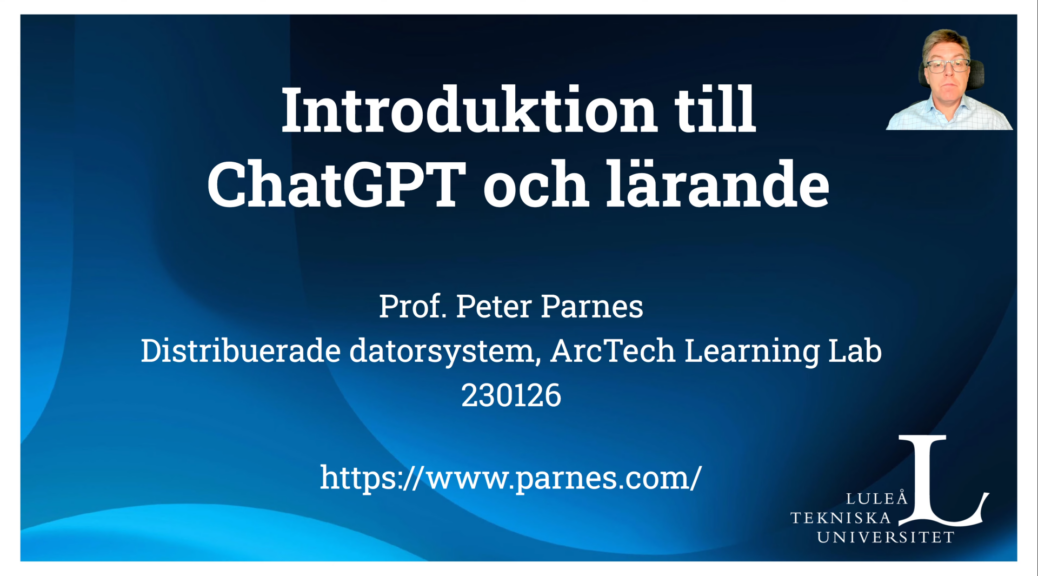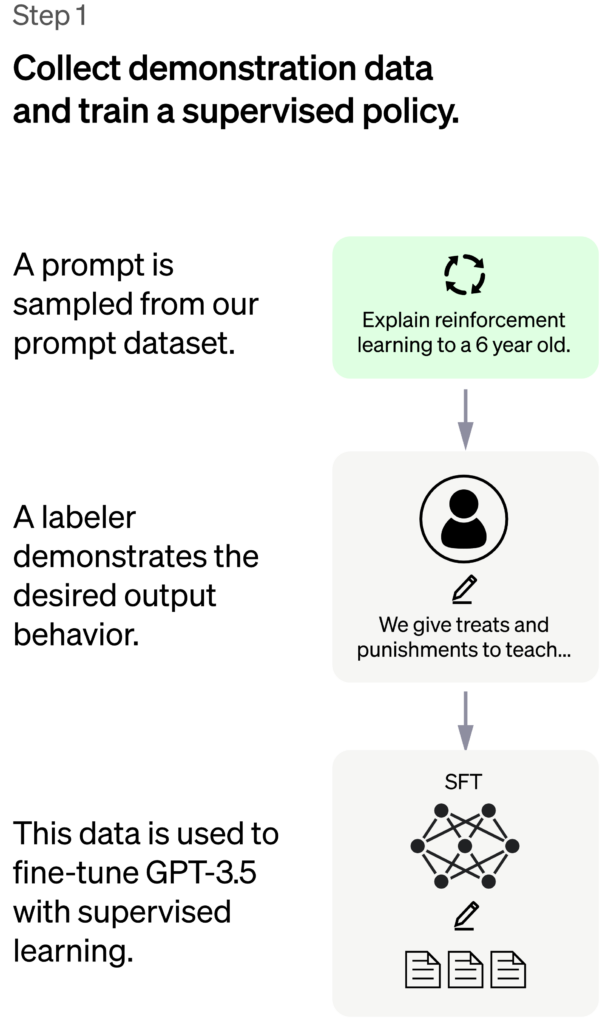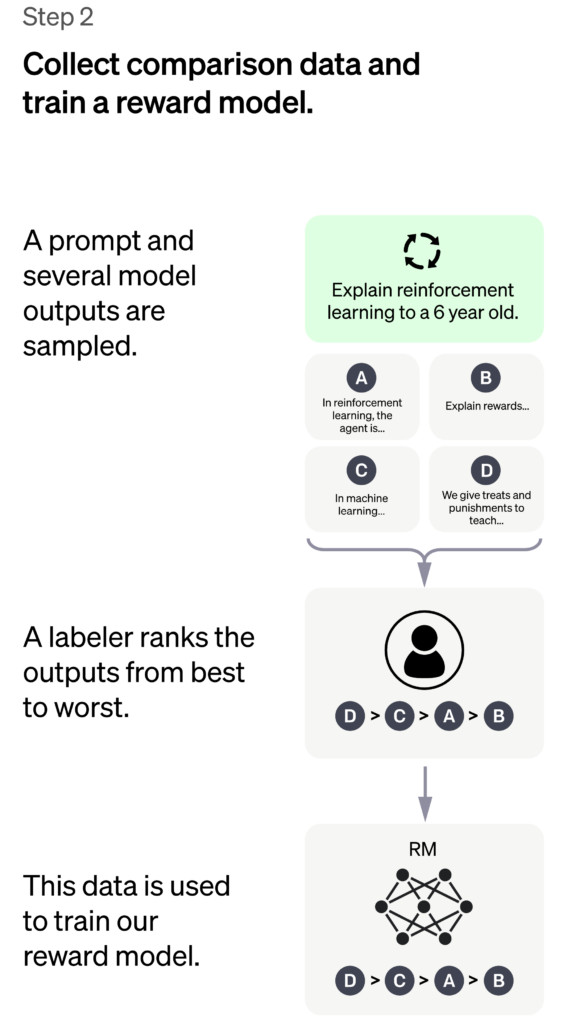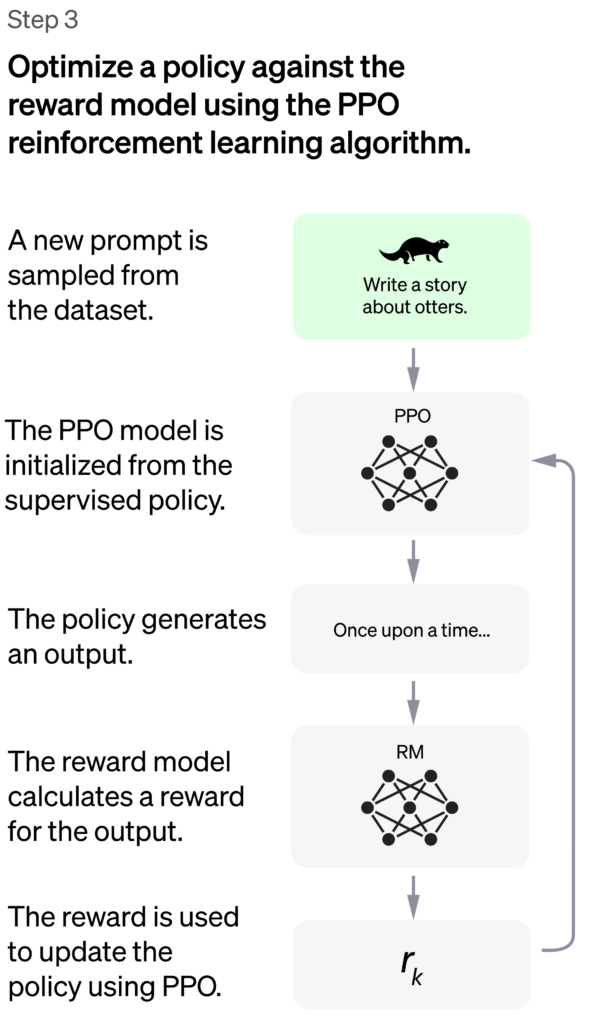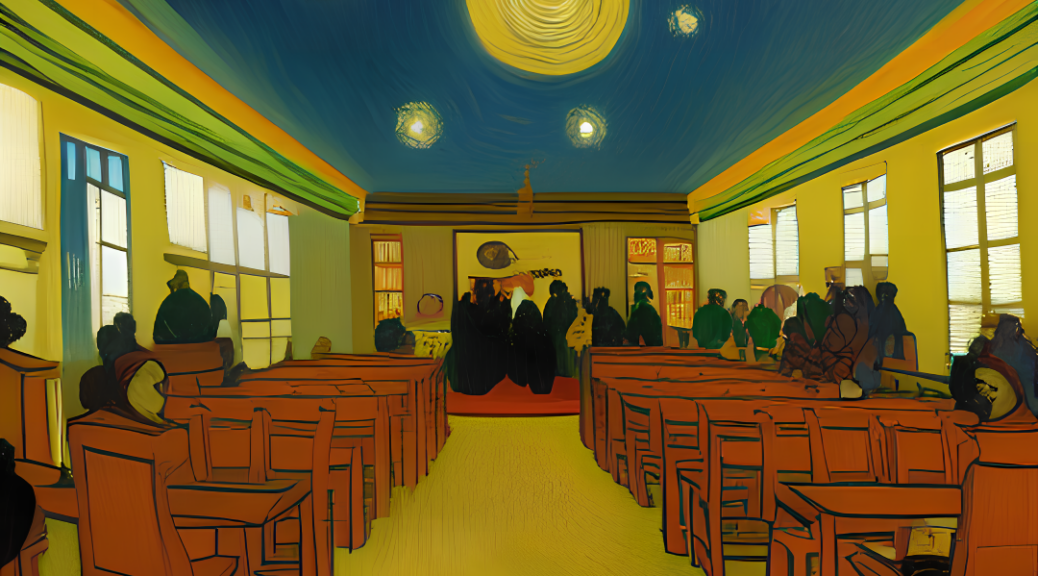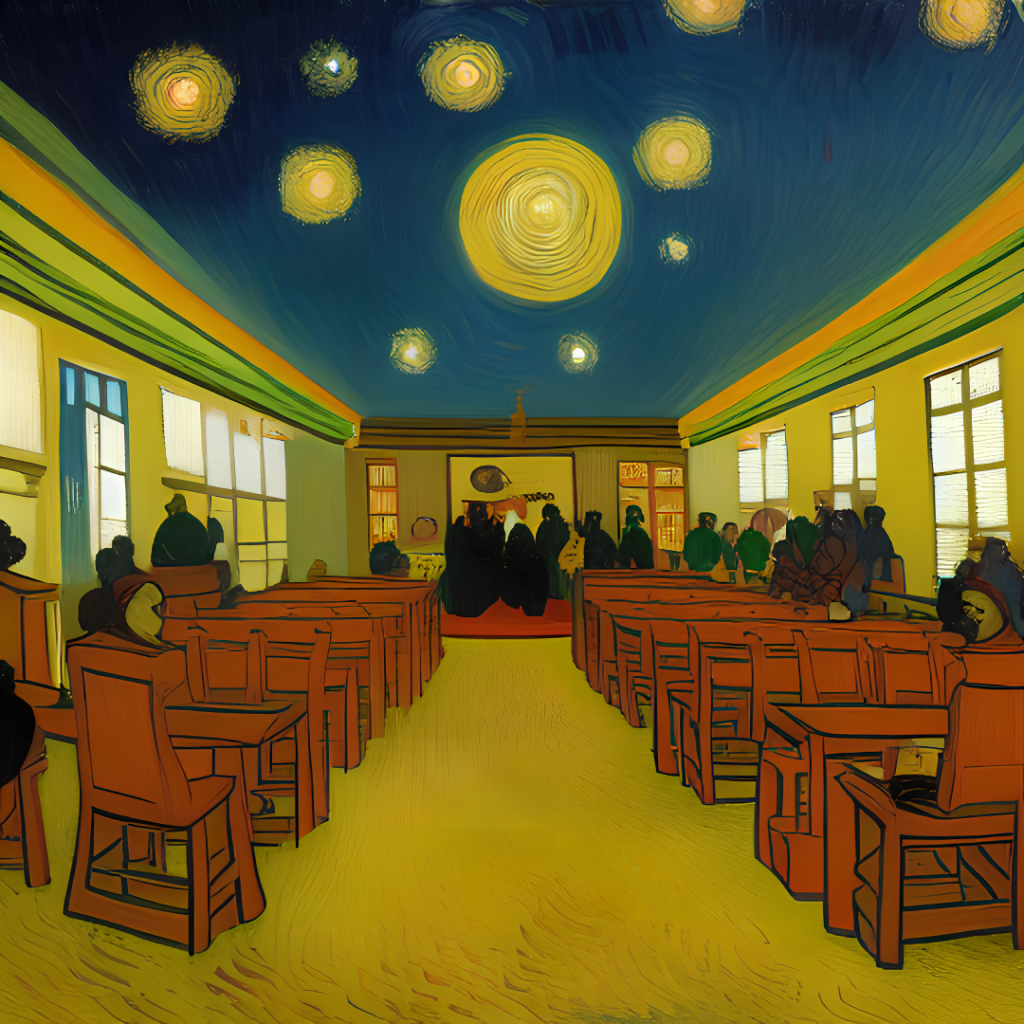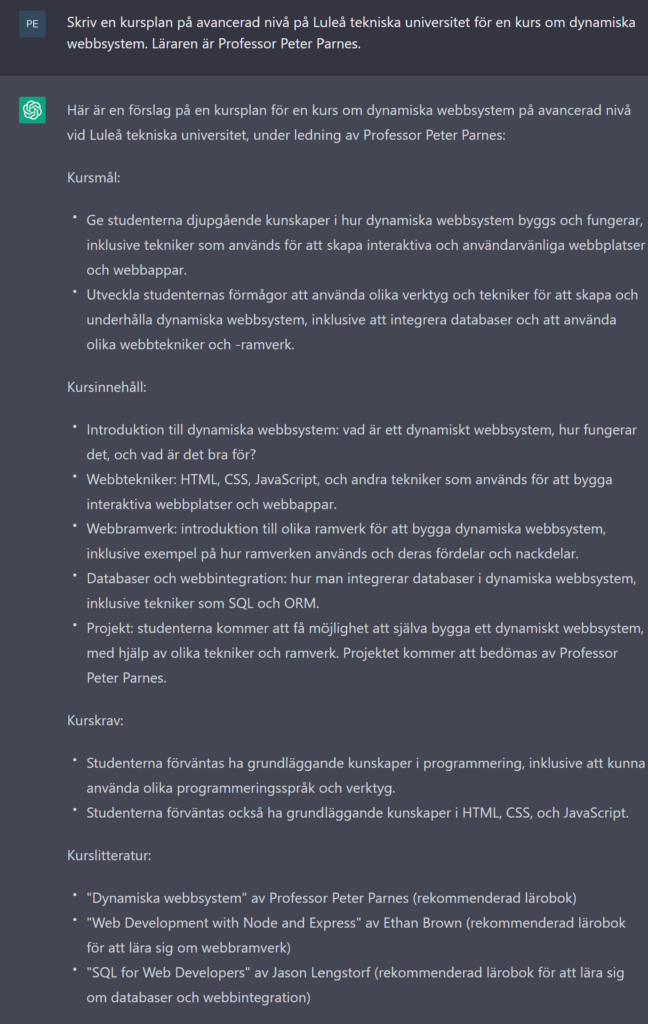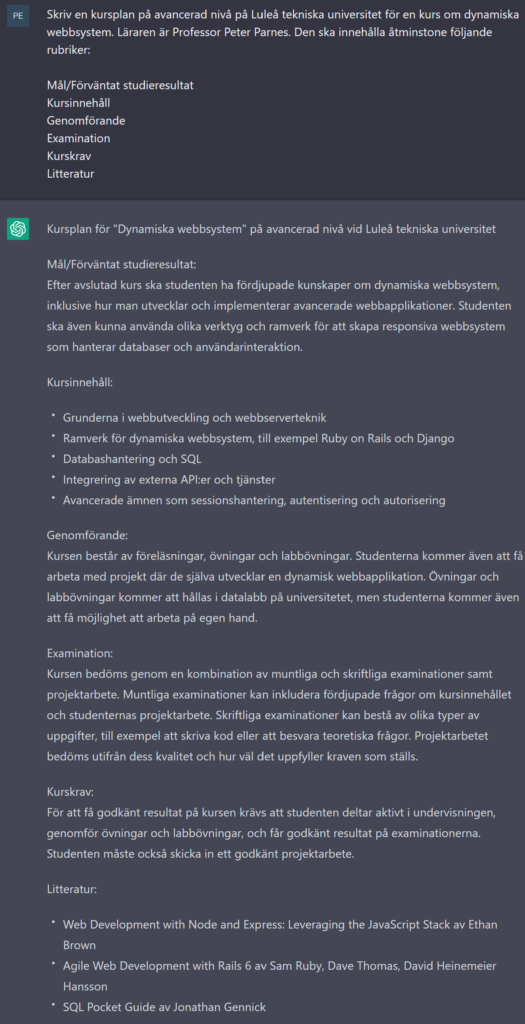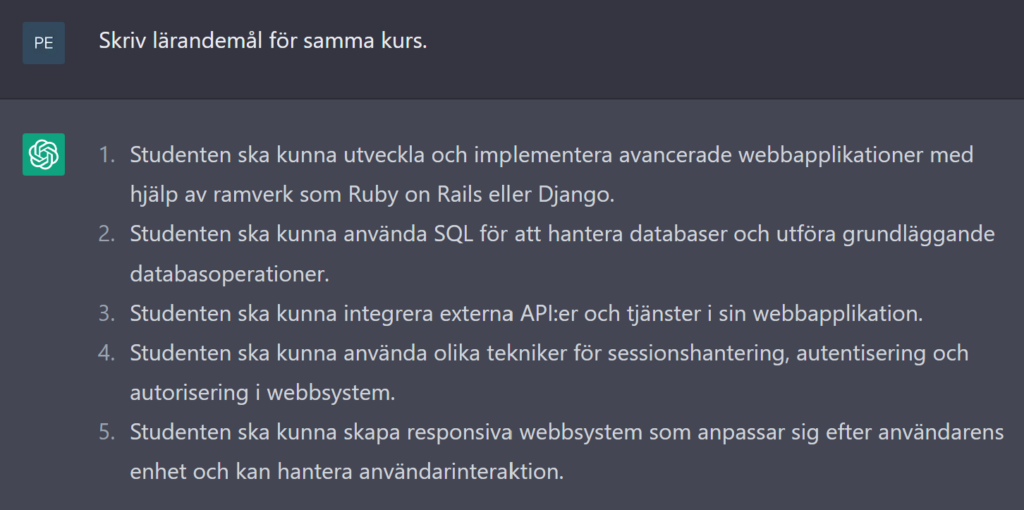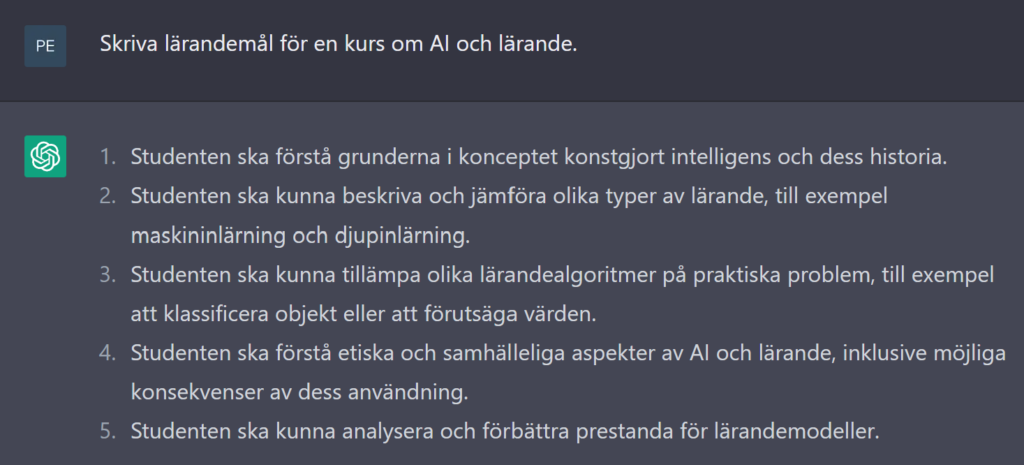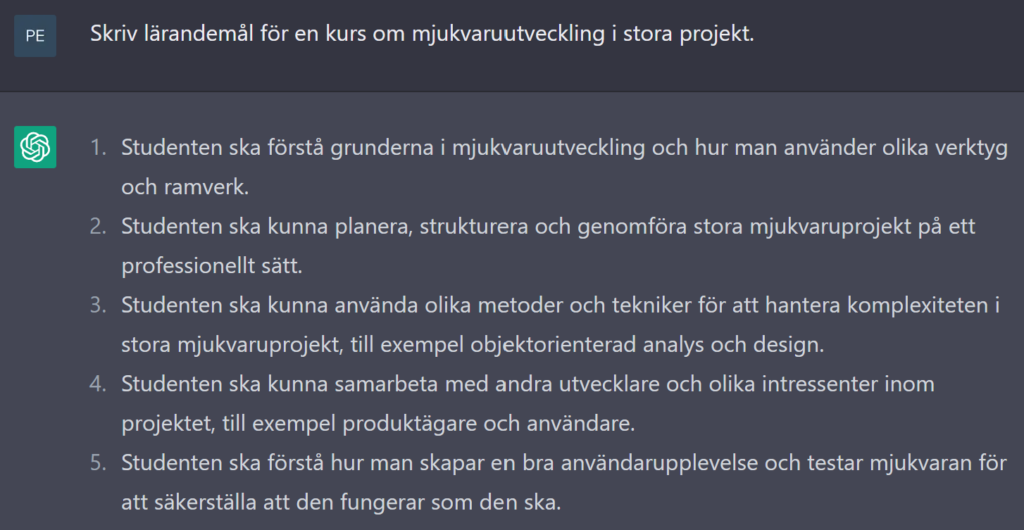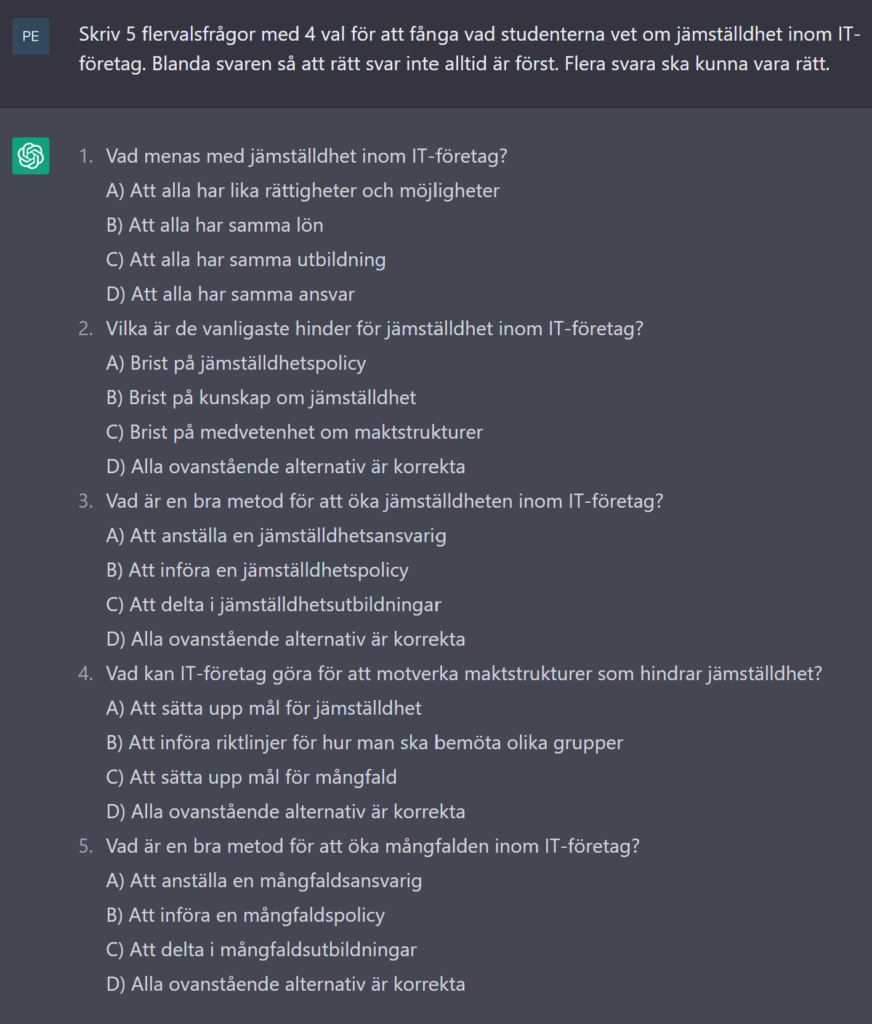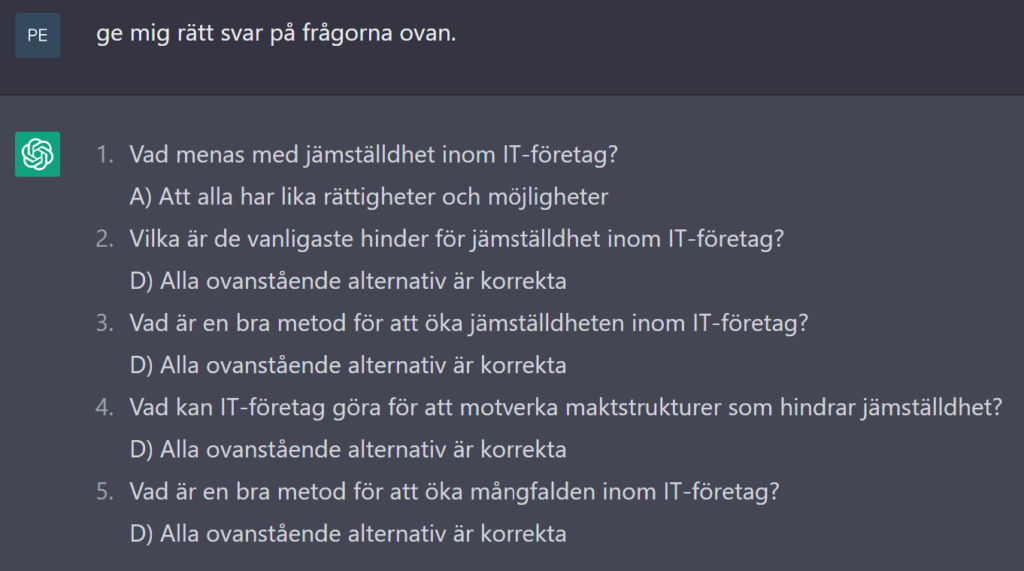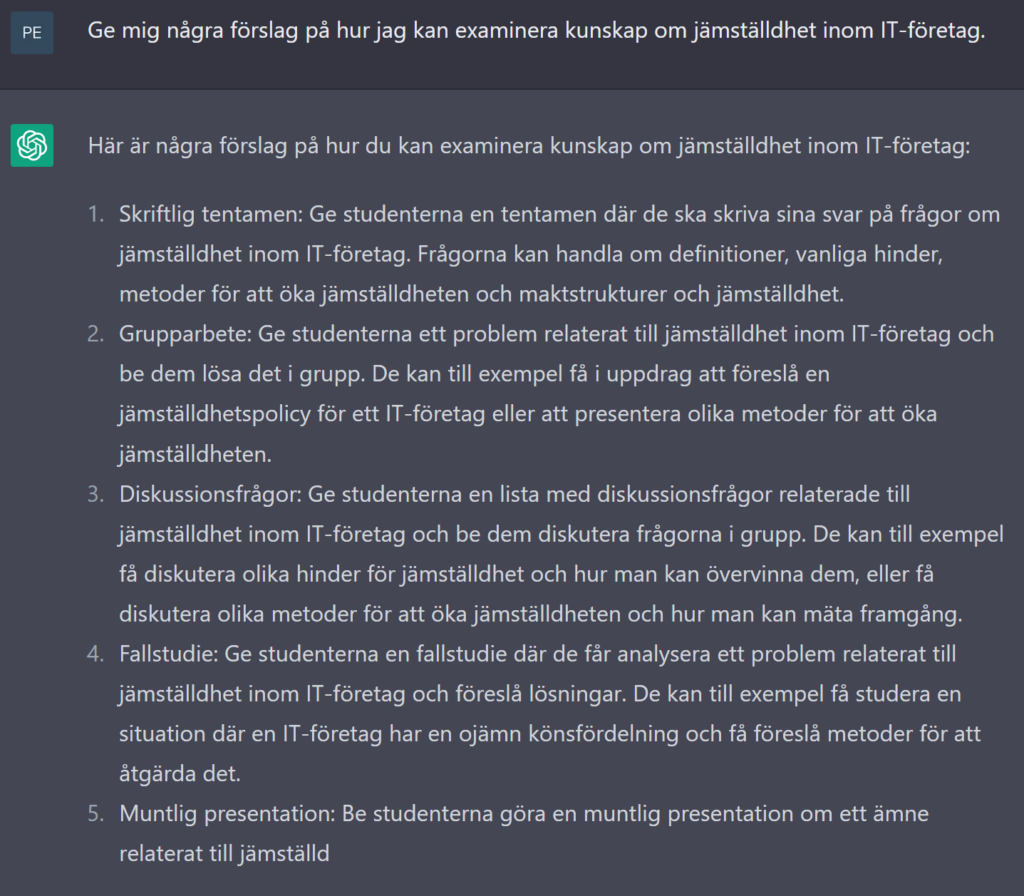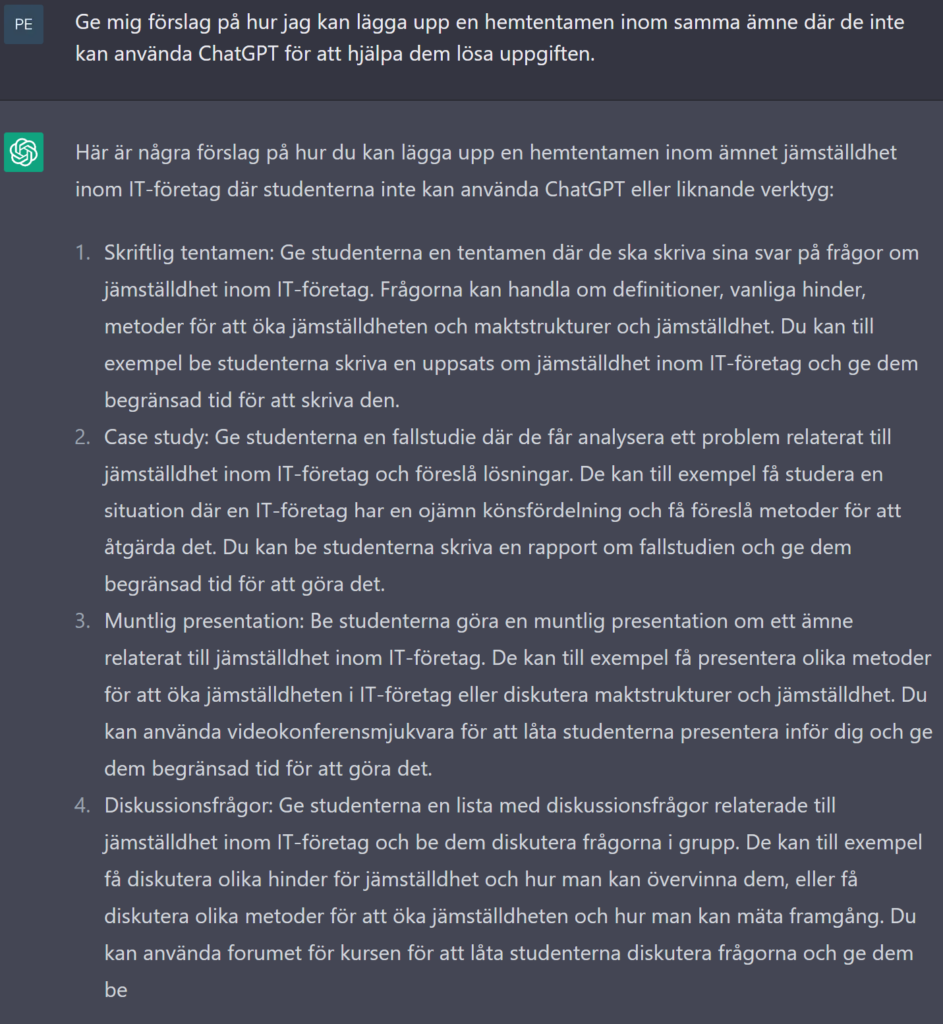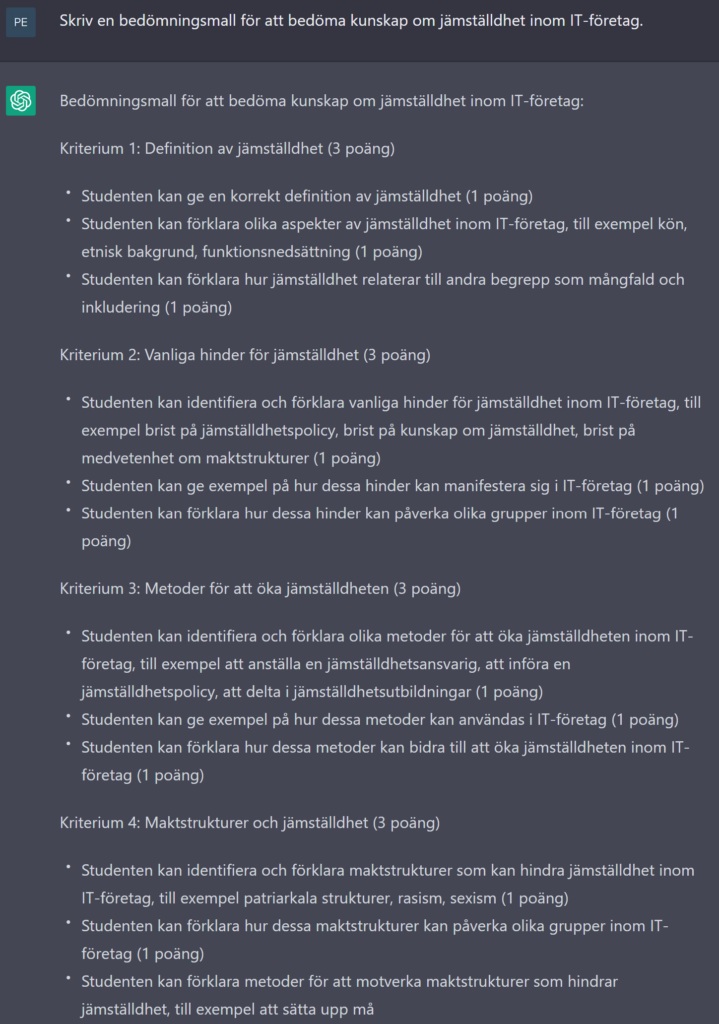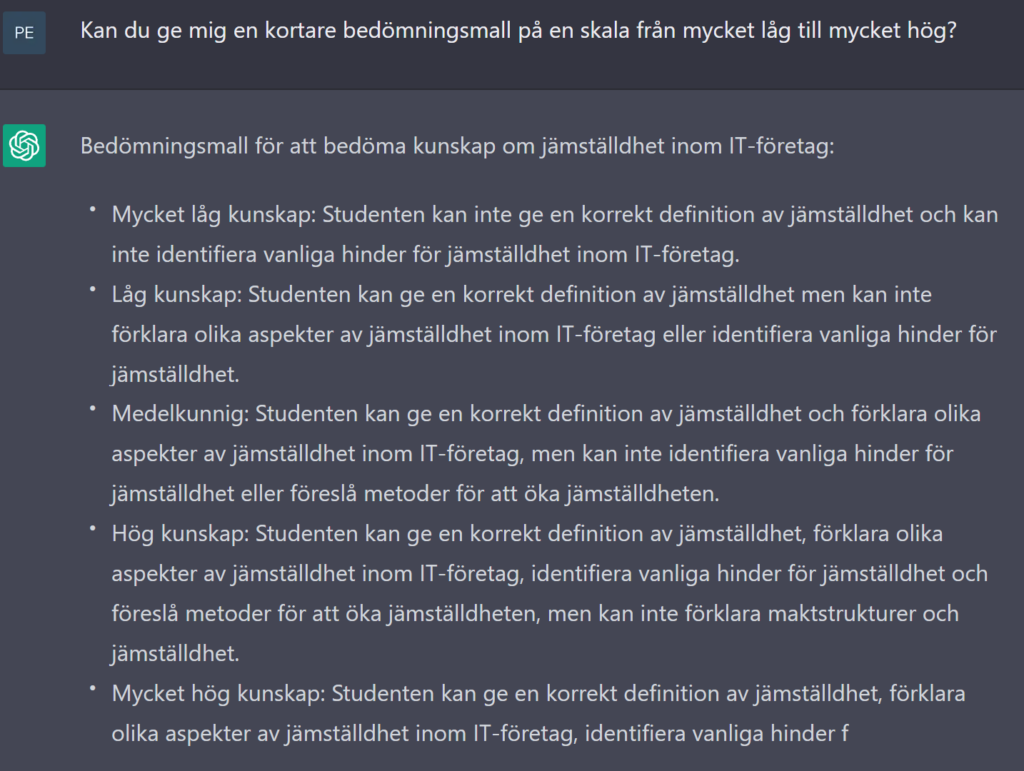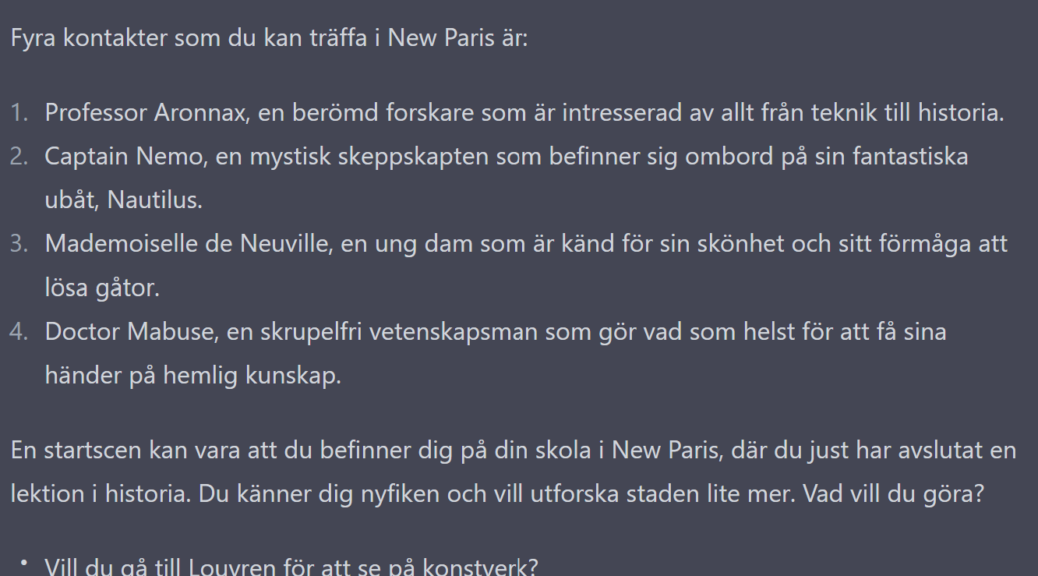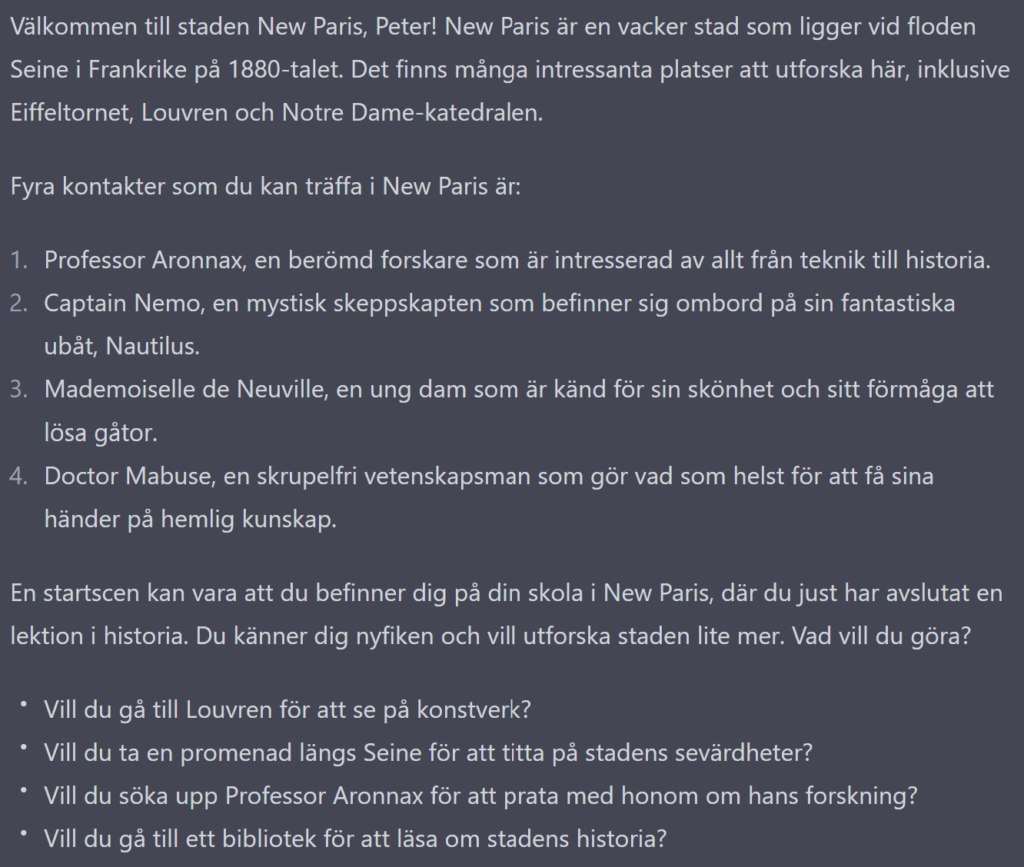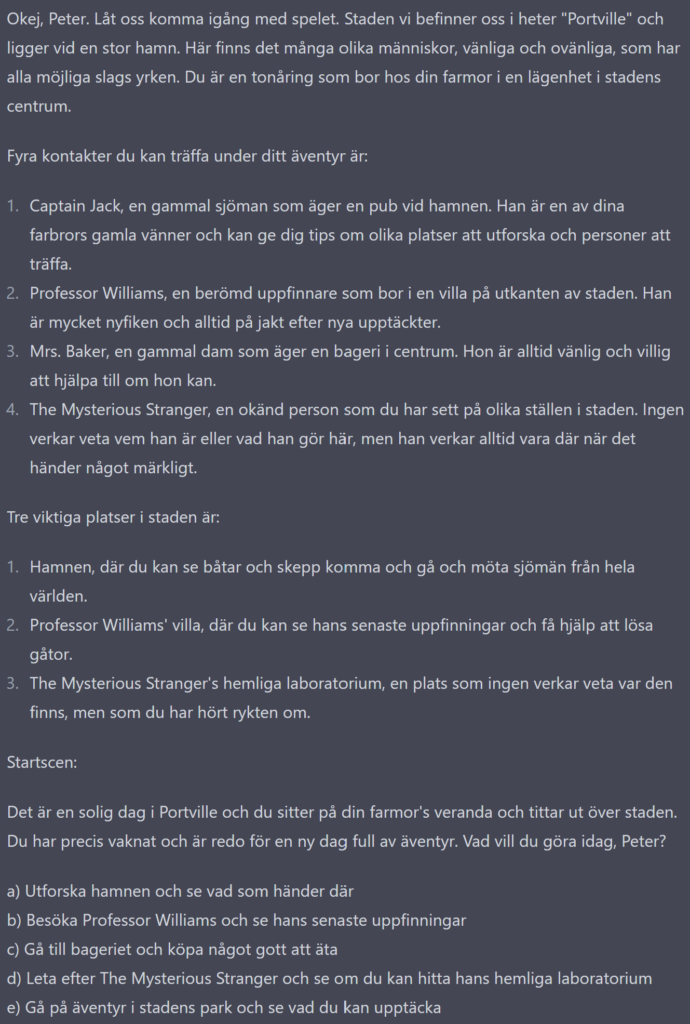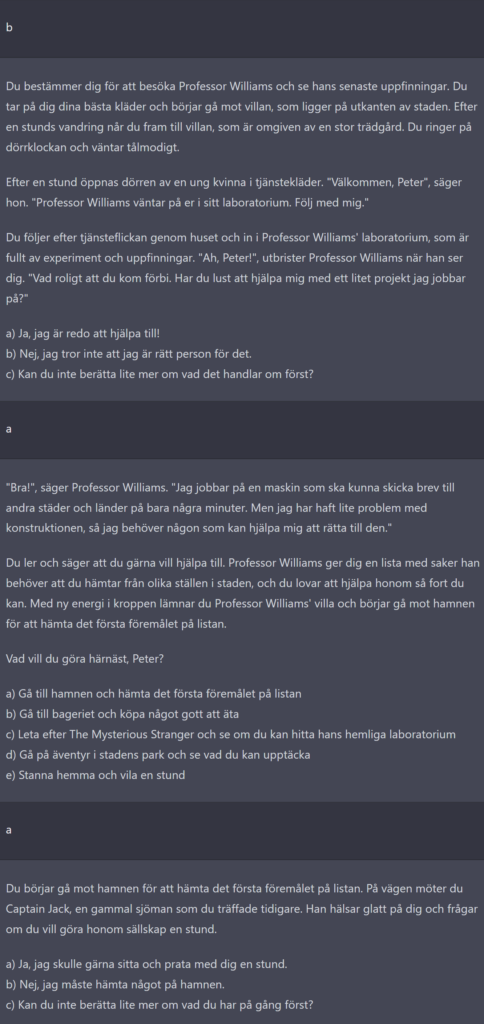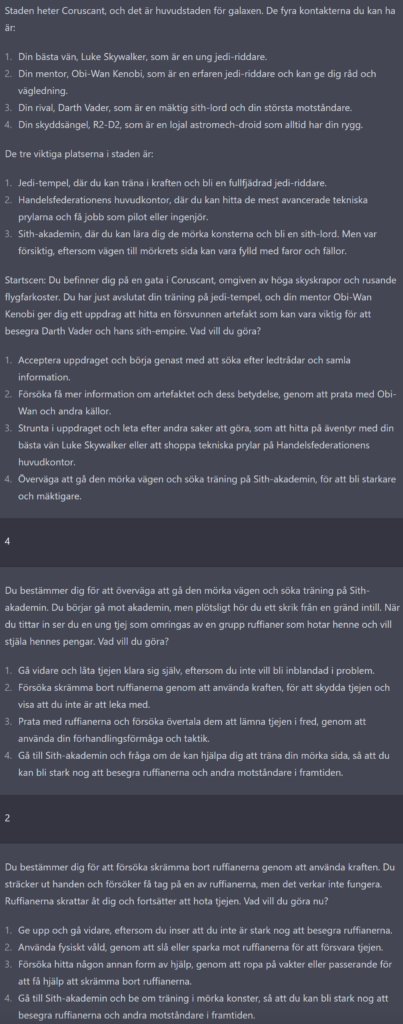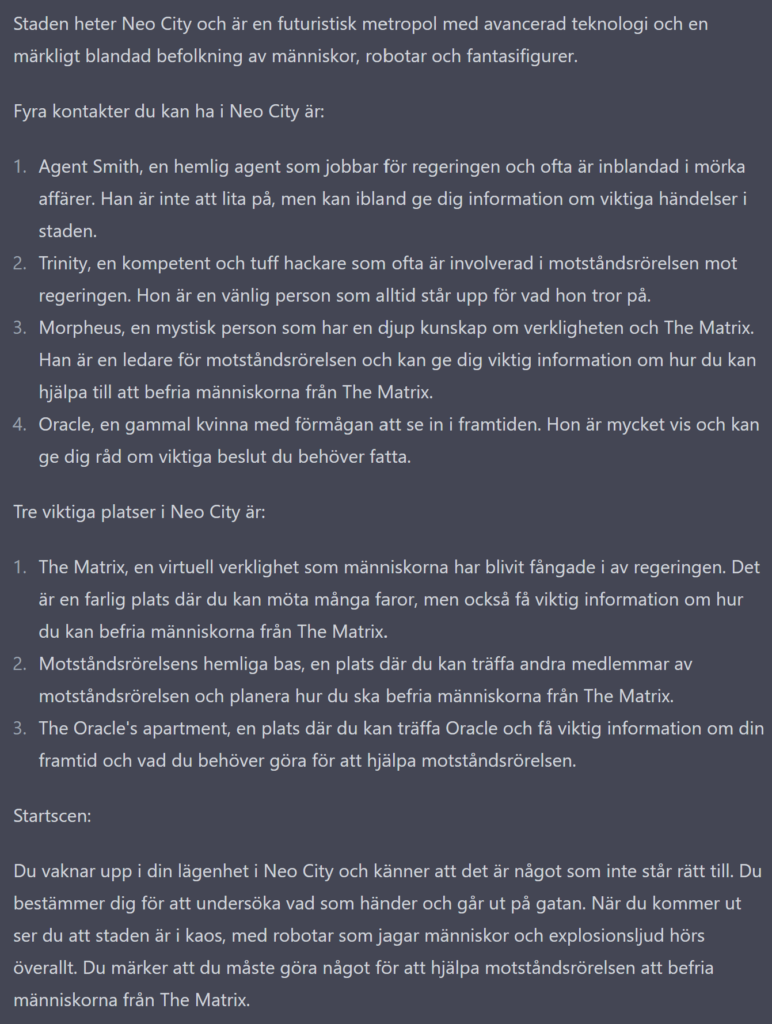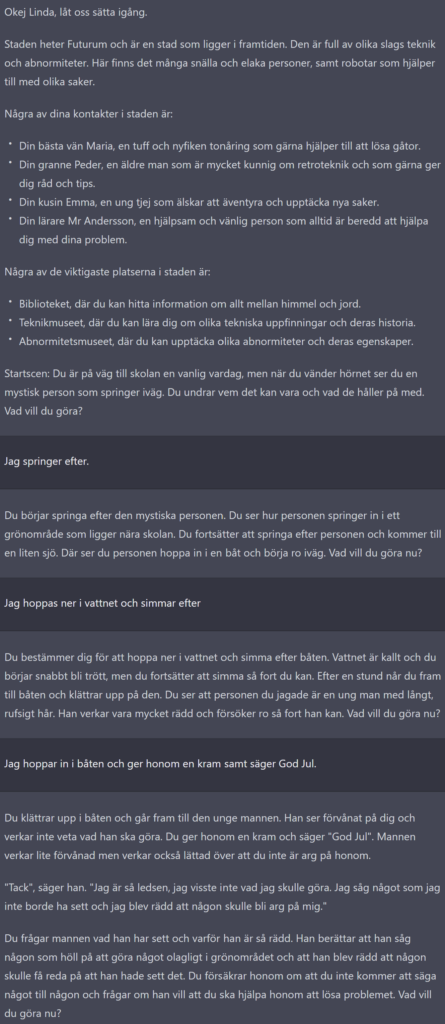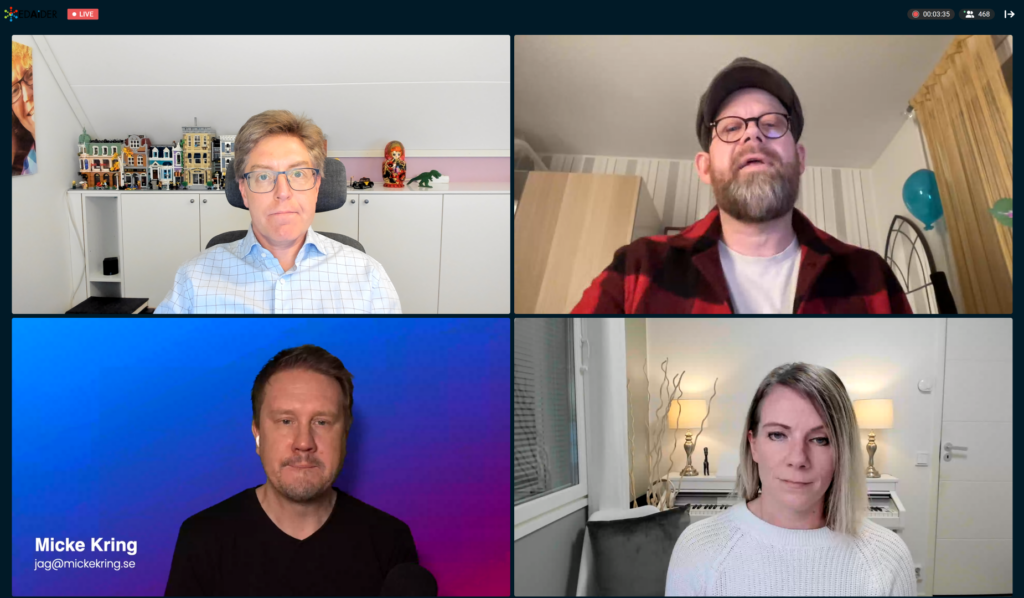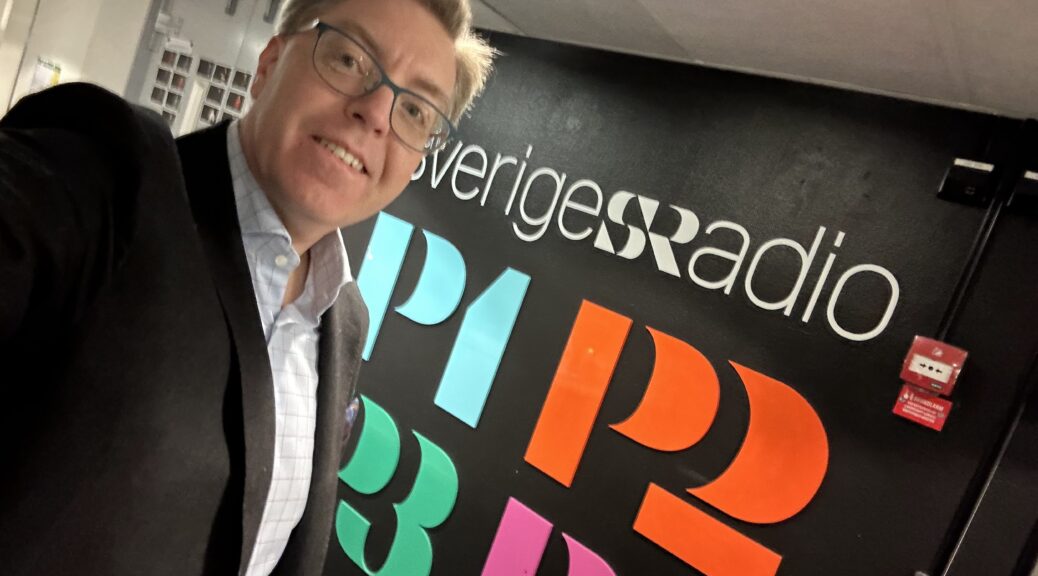I samband med seminariet 230112 så bad vi lyssnarna ställa frågor i förväg samt det kom ett antal frågor i chatten under eventet. Här har jag samlat alla dessa frågor och försökt besvarat dem. Jag tog mig friheten att rätta några stavfel i frågorna men i övrigt så är de kopierade rakt av. Jag har självklart tagit bort namnen på de som skrivit dem.
Detta kräver mycket pedagogisk utveckling: Mäktar lärare med? Behöver vi förändra lärares förutsättningar?
Ja, denna typ av verktyg förändrar förutsättningarna för lärarnas arbete och betyder att de måste delvis ställa om. Det betyder också att undervisningen på universiteten måste uppdateras för att inkludera utbildning om hur denna typ av verktyg kan nyttjas. Alla lärare måste fortbilda sig, oberoende av om det är pga, AI eller annan utveckling i samhället.
Kommer ChatGPT att förbli kostnadsfritt?
Det kommer definitivt att komma en betalversion som ger kanske snabbare svar, längre texter och snabbare svar. Jag tror det kommer att finnas en gratisvariant också framåt. Samtidigt kommer det också att komma flera olika konkurrerande tjänster som kommer att pressa ner priserna och tvinga fram gratisvarianter.
Hur källgranskar ChatGPT det som den levererar? Och hur hanterar den motstridiga kunskaper (“fakta”)?
ChatGPT är en matematisk modell som nya fakta om den inte har dessa i sin modell redan. Den interpolerar mellan fakta som den känner till och ger oss nya påstående helt utan källkritik.
Är det mer eller mindre rättvist att EN AI rättar ALLA proven, än om hundratal individer rättar, på lite olika sätt… Att det är mot reglerna är förstås givet. Kontrollrättning av AI, värdefullt bara det.
Jag håller med om att detta vore attraktivt att be ChatGPT rätta alla prov och det vore intressant att undersöka hur det skulle bli i jämförelse med om olika lärare rättade proven. En fördel med att ett program/AI rättar är att det skulle kunna göras mycket snabbare och eleverna skulle kunna få återkoppling direkt de är färdiga med provet.
Viktigt att beakta de juridiska aspekterna samt kontrollera att rättningen faktiskt blir lika varje gång.
Hur kommer chat GPT påverka våra arbetssätt med exempelvis större skriftliga inlämningsuppgifter för elever? Hur behöver vi förändra vår undervisning/läxor/inlämningsuppgifter/hemtentor osv?
Ja, lärarnas arbetssätt måste förändras om det finns verktyg som kan lösa uppgiften direkt utan att eleverna behöver anstränga sig alls. Jag tror det är viktigt att fundera på hur istället ChatGPT kan nyttjas för att hjälpa eleverna att lära sig nya saker.
Vem står bakom ChatGPT?
Det är företaget OpenAI i USA som grundades 2015.
Hur ser ni på att be elever skapa konton på exempelvis ChatGPT? De behöver ju lämna ut vissa uppgifter. Och hur blir det när det blir en kostnad för att registrera sig? Vi fick frågan från en lärare hur han skulle kunna skapa konton för sina elever utifrån gdpr (han önskade att använda den) 😉
Juridiskt: Utan att skriva ett personuppgiftsbiträdesavtal, PUB-avtal enligt dataskyddsförordningen (GDPR) med OpenAI så är det inte tillåtet att använda detta verktyg i skolan. Skolhuvudmannen kan inte kräva att eleverna ska skapa konton för att nyttja denna typ av verktyg. Vidare så skriver OpenAI att allt som skrivs in i ChatGPT kommer att sparas och du har ingen möjlighet att få något raderat. I alla fall inte i den nuvarande versionen.
Men om nu undervisning ska vila på vetenskaplig grund och Beprövad erfarenhet – hur vet vi om ChatGPTs undervisningsförslag är bra?
Det vet vi inte alls. ChatGPT bygger på en matematisk modell och ChatGPT interpolerar fram olika svar utifrån vad den lärt sig. Den gör helt enkelt kvalificerade gissningar. Här kommer arbete med källkritik in.
Den ger bra formativa kommentarer när elever skriver berättelser.
Återkoppling är ett bra användningsområde för ChatGPT som kan hjälpa elever att bättre förstå sina egna och andras texter.
Jag har testat att låta ChatGPT göra bedömningar av elevtexter utifrån givna kriterier. Spännande var att den gav allt från F-A på samma text varje gång jag bad den försöka igen på samma text. =)
Det visar att ChatGPT i sin nuvarande form inte är lämplig för att nyttjas för just detta.
När tror ni ai-funktionen som ChatGPT, börjar bilda egna uppfattningar, egna åsikter?
Detta är en djup fråga. Var är egentligen en egen uppfattning eller egen åsikt? Jag som människa skapar mig en uppfattning av omvärlden baserat på data och fakta som jag tar in i min hjärna, behandlar och drar slutsatser av. Vad skiljer detta från en AI-hjärna som gör samma sak? Betyder det att ChatGPT redan har en egen uppfattning eller en egen åsikt?
Kan man fråga ChatGPT om det är den som skapat ett elevsvar?
Nej, inte i nuvarande gränssnitt i alla fall. ChatGPT sparar antagligen alla svar den skrivit för att OpenAI ska kunna använda dessa för träning i framtiden men vi som användare kommer inte åt dem. Sedan skulle det innebära privathetsproblem om alla svar är tillgängliga för alla, eller i alla fall frågorna. En intressant funktion dock där vi som användare skulle kunna kopiera in en text och låta ChatGPT jämföra i sin egen databas om den finns där. Dock, vad skulle det betyda om texten är nästan likadan? Dvs., om en elev har ändrat några ord eller meningar? Är det då samma text eller en annan text?
Hur tänker ni kring att elever kan fuska med hjälp av chatt-GPT vid inlämningar!
Att uppgifterna måste göras om. Om ChatGPT kan lösa uppgiften rakt av så måste inlämningarna kompletteras med t.ex. muntlig examination.
Jag har märkt att ChatGPT då och då svarar helt fel vad gäller fakta. Hur kan man lita på den tjänsten när man skapar Quiz? Måste man inte dubbelkolla allt?
Du kan inte lita på vad den ger dig helt enkelt så du måste dubbelkolla allt. Intressant övning av källkritik.
Har ni några förslag på hur vi lärare skulle kunna hindra att eleverna fuskar via AI vid t.ex. Uppsatsskrivning?
Nej. Detta verktyg ställer helt inlämningsuppgifter åt sidan och lärarna måste fundera på alternativa eller kompletterande examinationsuppgifter.
Hur ser man till att eleverna skriver sina uppsatser och inte chat GPT?
Detta är en stor utmaning. Det finns flera initiativ och verktyg för att hitta om det är en AI som skrivit en text men det kommer inte att fungera. I och med att texterna skrivna av AI/ChatGPT blir väldigt lika de som människor skriver själva så blir de svårare och svårare att skilja på.
Ett verktyg som nyligen lyfts fram nyligen är GPTZero och jag provade själv men det fungerade mycket dåligt. Jag gjorde tre försök med längre texter som ChatGPT skrivit och där jag inte ändrat ett enda ord och de landade på 20-30% sannolikhet att de är skrivna av en AI. Det stora problemet är dock att denna typ av verktyg ger bara sannolikheter för att det är AI som skrivit texterna och inte “bevis” för plagiat jämfört med om eleven har kopierat en hel mening eller paragraf. Säger eleven nej (dvs., ljuger) så kan inte läraren bevisa motsatsen oberoende av vad verifieringsverktyget säger.
Hur kan vi lärare använda detta verktyg i vårt planeringsarbete och som stöd?
Du kan be ChatGPT om att ge förslag på hur lektionen ska läggas upp. T.ex. be den om progression i olika ämnen. Den ger kanske inte ett svar som är direkt kopplat till den svenska läroplanen men det är ofta en bra start. Jag har själv använt ChatGPT för detta flera gånger i olika diskussioner och planeringar.
Hur kan eleverna använda verktyget utan att deras utbildning tar skada, det vill säga fusk osv.”
Här handlar det mycket om att motivera till lärande. Dvs., hur kan vi motivera eleverna till att vilja lära sig saker och istället använda ChatGPT som ett hjälpverktyg. Mitt förslag är att generellt fokusera mindre på fakta och att istället för att skriva långa texter låta eleverna öva på kommunikation och presentation, kritiskt tänkande och samarbete där de i olika former får komma fram till svaren själva, kritiskt granska dessa och presentera vad de kommit fram till.
Dessa tjänster ställer stora krav på att reformera utbildning och examination, åt håll som vi gärna vill utveckla dem, men kan vi?: Vilka resurser behövs för att reformera utbildning och examination?
Hur examinationsformer påverkas när elever inte kan skriva oövervakade hemuppgifter som kan bedömas på ett tillförlitligt sätt
Ja, detta kräver en hel del arbete av lärarna och rektorerna som ska vara de pedagogiska ledarna. Här behöver alla inblandade fundera på hur skolan förändras när vi har denna typ av AI-verktyg. Notera att ChatGPT är bara det första kraftfulla och användbara verktyget och vi kommer att få se många nya verktyg redan i år och denna typ av verktyg kommer bara att bli ännu mer kraftfulla inom en mycket snar framtid.
Hur kommer detta påverka examinationsformerna vad gäller skrivandet i skolan?
Lärarna måste fundera på vilka examinationsformer som bäst fångar elevernas kunskaper.
Har ni förslag på hur det kan användas i undervisningen?
ChatGPT kan både användas för att hjälpa lärare och elever. För lärare kan det vara t.ex. att skriva lektionsplaneringar, skapa progression för att lära ut ett visst ämne, bolla egna upplägg, skriva kursplaner och hitta nya infallsvinklar på undervisningen med mera. Här har jag skrivit om detta tidigare.
För eleven tror jag det finns stort värde i att ChatGPT kan förklara saker på olika sätt utan att tröttna och alltid vara tillgänglig för eleverna oberoende var och när de frågar. Läraren kanske inte hinner svara på alla frågor eller förklarar på ett sätt som eleven inte förstår och då kan eleven få hjälp när den behöver det.
ChatGPT kan också t.ex. Hjälpa till med skrivkramp eller om eleven har brist på kreativa idéer i ämnen där den kreativa biten inte är det viktiga. Dvs., det är inte fusk att be ChatGPT om hjälp med de delar som inte ska examineras.
Här har jag skrivit tidigare om hur ChatGPT kan användas för lärande.
Vilken roll ska “skolan” ha i förhållande till den nya tekniken? Ska vi automatiskt hoppa på eller behöver vi till viss del vara en motpol?”
Jag tror starkt på att de verktyg vi anser vara bra ska nyttjas för att hjälpa eleverna att lära sig mer. Sedan är det upp till varje lärare att fundera på vilka verktyg som är lämpligast att nyttja i just deras undervisningssituationer. Motpolen i just detta exempel med ChatGPT är att inte använda det alls och bara fortsätta som om det inte finns, vilket jag tror är helt fel för då kommer det bara användas för fusk vilket är ett klart sämre resultat.
“Varför tror ni att det är “fusk” och negativa aspekter som lyfts fram i media först och inte frågor som är kopplade till hur AI kan hjälpa både elever och lärare som hörs?
Människan är i sin natur försiktig och rädd för förändring. Här kommer något väldigt radikalt nytt som kommer att påverka skolan otroligt mycket och då blir folk rädda och kanske bara ser det negativa. Jag tycker vi här istället ska gemensamt försöka lyfta fram möjligheterna med den nya tekniken och hur det i stort kan hjälpa eleverna att lära sig mer.
Jag önskar fokus på hur man kan jobba MED ChatGPT och inte mot; hur vi kan förändra examinationer och bedömningstillfällen och hur vi kan använda ChatGPT för att underlätta för oss som lärare.
Jag också 🙂 Tycker det är mycket viktigt att vi fokuserar på möjligheterna och inte bara hot och hinder.
På vilka sätt kan ChatGPT eller liknande tekniker användas som ett verktyg för lärare och elever?
Se ovan.
Kan det finns fördelar med att lära eleverna verktyget på skolan?
Ja, definitivt. Min personliga dröm är att alla som ska lära sig något har en personlig digital assistent som kan hjälpa dem att lära sig mer och lära sig snabbare. ChatGPT kan ge dem alternativa förklaringar och kanske därmed också ge ett djupare lärande så att de faktiskt kommer ihåg vad de lärt sig i skolan.
Hur ska vi tänka kring fusk i samband med ChatGPT?
Att vi måste anpassa examinationen och uppgifterna så att de inte går att lösa rakt av med hjälp av ChatGPT samt motivera eleverna till lärande. Varför är de i skolan över huvud taget?
Funderar lite över dels likvärdigheten och dels GDPR – kan lärare (och elever?) skapa ”skolkonton” för att använda kontinuerligt i undervisningen, till exempel som en ”dopad study buddy”? Så att eleverna faktiskt får lära sig att använda det (tror inte på att förbjuda och stänga in) och lära sig att tex skriva bra och prompts och uppföljningsfrågor för att precisera. Känns som en självklar del av digital kompetens idag.
Jag ser nyttjandet som en självklart digital kompetens som alla elever (och lärare) ska övas i. Dock är dataskyddsförordningen ett hinder och vi får inte använda ChatGPT utan att skriva ett personuppgiftsbiträdesavtal, PUB-avtal med OpenAI, företaget bakom ChatGPT. Tror dock inte att de kan uppfylla alla villkor som t.ex. att allt data ska ta bort om användaren vill det så det blir svårt att få till denna typ av avtal. Här går nyttjandet emot lagkraven tyvärr.
Hej! Många lärare ser ChatGPT som “besvärligt” i skolsammanhang för det ställer till våra tankar om hur vi kan mäta elevers kunskaper och hur vi vet att de gjort sina arbeten på egen hand. Men om vi vänder på det, har ni några tankar kring hur vi lärare kan dra nytta av ChatGPT i arbetet med våra elever? Jag kan ju i och för sig fråga den själv vad den tycker 😉
Som jag skrivit flera gånger ovan så gäller det att se möjligheterna med ChatGPT och liknande AI-verktyg. Dvs, hur kan ChatGPT hjälpa eleverna att lära sig mer. Samtidigt så måste varje lärare fortbilda sig och ta tiden att lära sig nya verktyg som är bra att kunna.
Finns det möjlighet att i befintliga plagiatkontroller, såsom Urkund, lägga in en mekanism som kontrollerar om texten är AI-genererad? ChatGPT hävdar själv att den kan avgöra om texter är skapade av en AI eller ej.
Nej, jag tror det blir mycket svårt. Verifiering av AI-skapade texter kan bara komma till att de ger en sannolikhet att de är skapade av en AI. Om då eleven säger nej så har inte läraren några bevis. Vidare har jag provat flera existerande verktyg som finns redan idag och i kort så fungerar de inte. De tittar på hur texten är uppbyggd, dvs, vilket språk som används, inkl. Hur långa eller korta meningarna är och det är något som varierar mycket mellan olika individer samtidigt som verktyg som ChatGPT kommer att bli otroligt mycket bättre på att skapa texter än vad de är idag. Sedan kan vi fundera på var gränsen går för vad som är eget material om jag börjar med en text från ChatGPT men skriver om den. Är det då fusk eller inte?
Detta är en mycket svår fråga och kommer tillbaka till formuleringen vi använder på universitetsnivå att det inte får vara vilseledande examination. Dvs, studenten får inte luras helt enkelt. Om de luras i alla fall så är det svårt att motbevisa.
Människa + maskin = sant?! I arbetslivet kommer vi snart arbeta med AI av typ ChatGPT för textproduktion. Kan man hjälpa elever och studenter att hantera verktygen genom att använda dem i undervisning och examination? Att ställa frågor som “Diskutera de i din mening viktigaste begreppen som förekommer i kurslitteraturen”. Uppgiften blir att granska AI:s svar, ta bort felaktigheter (som fejkade referenser som ibland förekommer), bedöma relevansen osv. För att ställa bra frågor behöver man ha läst kurslitteraturen. Läraren bedömer frågorna och hur man redigerat AI:s svar. Är detta tillräckligt för att ge elever/studenter den träning som behövs för att de ska kunna förstå och strukturera komplexa och stora textmängder – vilket är en central del av t.ex. en samhällsvet. utbildning?
Jag tycker detta låter som ett mycket bra förslag på hur ChatGPT kan nyttjas och ett bra exempel på hur du tänkt på hur verktyget kan nyttjas för ett ökat lärande. Sedan om det är tillräckligt för att de ska ta till sig att det de ska lära sig kan efterföljande examination visa. T.ex. genom muntliga diskussioner.
Hur ska vi förhindra att skolorna enbart reagerar med förbud och t.ex. går över till endast låsta prov som examinationsform
Genom upplysning om möjligheterna där lärarna själva måste säga att de kan och vill nyttja denna typ av verktyg.
Finns det några sätt som man kan ta med ChatGPT i undervisningen/lärandet, så att elever/studerande kan utnyttja ChatGPT med tillstånd och lära sig med hjälp av den.
Om vi för tillfället bortser från den juridiska problematiken (GDPR) så är det bara att köra på. Det finns massor med saker som ChatGPT kan nyttjas till i skolan för att öka elevernas lärande.
Framtidens arbetsmarknad för akademiker och hur den kommer att påverkas av den här typen av verktyg 🙂
Jag är inte orolig för att akademikers jobb är i fara ännu. Dock ser jag verktyg som ChatGPT som ett otroligt användbart verktyg för att hjälpa oss i våra arbeten.
En fundering som jag har är hur denna typ av verktyg kommer att påverka hysterin runt publicering av akademiska publikationer. Det publiceras idag massor med publikation som väldigt få läser. De publiceras enbart för att forskarstuderande eller forskare ska meritera sig. Det handlar mer om volym än om att sprida viktiga forskningsrön.
Hur troligt är det att applikationer liknande ChatGPT dyker upp i år, där applikationen dessutom har någon funktion för att utvärdera om svar är logiskt sammanhängande?
Jag tror det är mycket stor sannolikhet att det kommer. Redan nästa version av den underliggande AI-hjärnan som kommer under våren 2023 kommer att bli bättre och förhoppningsvis också ge oss mer logiskt sammanhängande svar. Vi får helt enkelt vänta och se.
För att skapa ett konto hos OpenAI behöver man vara 18 år. Utifrån det, hur stor är möjligheten att låta elever använda ChatGPT som en del av undervisningen?
Juridiskt så är svaret nej. Det går inte. Tyvärr. Här måste varje skolhuvudman fundera på hur de ska förhålla sig.
ChatGPT baseras på motor GPT3 som är över 1 år gammal. Vad vet ni om den kommande motorn GPT4?
GPT3 (eller OpenAI kallar den för 3.5 i ChatGPT) är som du skriver redan gammal. GPT4 ska komma under våren 2023 och ska vara tränad på många gånger fler parametrar. Exakt hur många fler parametrar eller hur mycket mer data vet vi inte idag. Sedan kommer själva ChatGPT att utvecklas också för att ge oss ännu bättre svar. Jag är övertygad om att den kommer att upplevas som otroligt mer kraftfull redan i nästa version jämfört med vad vi tycker idag.
